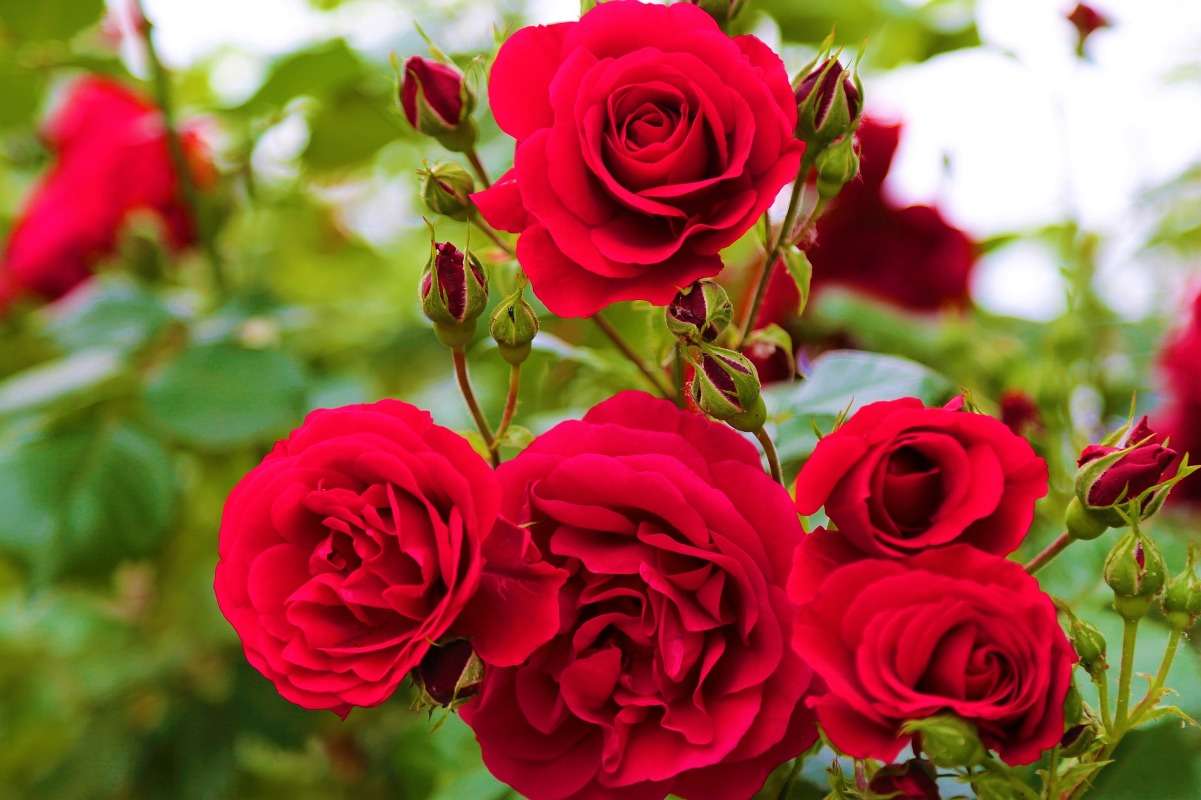Introduction: Hello flower gardeners, we are back with a great information of propagating rose plants from cuttings. Roses are the beautiful flowering shrubs popularly grown in gardens. Are you planning to propagate roses in your garden? Then you can go through these following points to propagate rose plants through cuttings.
A step by step guide to propagating rose plants from cuttings
You can grow the rose plants through cuttings which can be easily to grow roses in your garden but proper planting and care should be taken. The area where you grow roses should receive at least 6 hours of sunlight. Roses should be planted in an area where it is well-drained and fertile soil.
How to reproduce and regrow roses from cuttings
Usually roses are simple to grow and you can easily propagate and regrow them from the same plant. Propagating is nothing but re-growing or reproduce in the simple way from cuttings instead from seeds which take a lot of time. Through cuttings you can produce many replicas from the parent plant. You no need to be trained person to propagate through cutting. It is just a simple process just to prepare cuttings like pieces of stem collected at different stages of maturity. But few rose plants are particular about the type of cutting will root and few are flexible in rooting.
Different types of rose cuttings
Rose cuttings can be taken from new stems at three main stages of growth. These include-
Softwood cuttings
These give rise to fast growth of roots which should be collected during late spring and early summer, where the stems at this time begins to mature. These care called softwood cuttings. These prime softwood cuttings are pencil sized which are located below rose blooms and dropped their petals.
Semi-hardwood cuttings
These stem cuttings are collected during late summer and early fall, when new growing stems will partially mature. At this time these stems might have rosehips, before the blooming appears.
Hardwood cuttings
These cuttings will root slowly an sometimes difficult to root. These can be collected in late fall or early winter, where the stems have hardened matured and reaches their dormancy.
You can achieve the rooting in all these cuttings by treating the cuttings with root stimulating hormone which helps to stimulate the root development and in turn encourages the growth.
How to collect rose cuttings –things required
Based on the type of cutting you chose you can collect the stem cutting from southern regions or northern growing zones. You can even collect them based on their fading blooms instead getting stuck to the timings mentioned.
Before you start collecting the stem cuttings, you need these things-
- A clean and sharp knife without any rust or you can also use the bypass pruners.
- Make sure you are ready with lukewarm water which allows keeping the cuttings moist immediately after separating it from plant.
- Rooting hormone is necessary if you want to make sure to your cuttings starts root growth.
- A stick to make the holes in the mud to plant the collected rose cuttings.
You should not miss the How To Grow Malabar Spinach on Terrace from Seed.
Propagation of rose plants from cuttings – a step by step process

Step-1: Choose a stem near the withered loom and woody’s base and cut it at that area. This stem can make several cuttings. Make a note that choosing a strong, healthy stems above a set of leaves has capacity to rise into a separate plant quickly, that means it has great growing conditions.
Step-2:Clean the stem by removing the bloom and stem tip, later cut at 45 degree angle just above the first set of leaves at the bottom of the stem. Later place these stems in lukewarm water immediately to maintain the moisture level.
Step-3:Cut each stem into 6 to 8 inch lengths, make sure that each cutting has four nodes that is the area where leaves emerge on stems. Ensure that you need to maintain the moisture in all the cuttings.
Step-4: In this step you need to remove all theleaves for each cutting except at the top of each cutting. This helps in the more root production first and then starts with the shoot progress.
Step-5:First moisten the cuttings and then dip the areas of the cuttings (which should be planted in the mud) in rooting hormone until covered, as this induces root growth quickly so that you can make your garden filled with rose plants reproduced from the parent plant.
Step-6: Use a stick or pencil to make 3 to 4 inches of hole deep in the mud placed in a container or in the raised bed or the area in the garden. Make a sufficient bigger hole, so that you can insert the cutting without brushing off the hormone content stuck to the stem cutting.
Step-7: Put thecutting into the hole, so that half of its bottom should be covered with mud especially at least two nodes should be covered and then make sure that the cutting is firmed with the soil. If you are planting multiple cuttings then you need to maintain at least 20 cm apart in between the cuttings placed.
Step-8:The final step is the most important one to attain successful reproduction from rose cutting is that water them frequently and keep the area moist in the surrounding areas of cuttings planted. You can also create a mini green house for these rose cuttings by covering them with the plastic bag around the cutting after water them. This maintains the moisture content and forms a mini greenhouse for these rose cuttings.
Step-9: Monitor the rose cuttings to ensure that they are hydrated regularly and whether they are developing roots. You can check these by observing the roots growing gently tugging into the soil. This can be tested by observing the slight resistance with 1-2 weeks after planting the rose cuttings in the soil. This means the cuttings has induced root growing well deep into the mud.
Step-10: Slowly allow these cuttings to harden before transplanting them into the outside garden or separating them into the pots. So that you can provide good space for them to grow freely. These should be placed in cool and shady areas as the immediate hot sunlight might damage their growth.
You may also like the How to Protect Your Garden from Rats, Mice, Rodents.
Different methods of stem propagation by cuttings
You can also propagate rose cuttings by using natural root growth stimulants like-
Root growth by using honey
Instead of growth hormone you can also use honey which is a natural stimulant of root growth, but make sure that this should not be planted directly into soil. If the cutting is dipped in honey then it should be placed in a bottle of water and it starts growing roots within a week. Later after observing the root formation then you can plant this into the mud.
Planting the cuttings into the potato
You can also plant the rose cutting in potato, but do not push the stem clear through the potato. Potato helps to maintain the good moisture content along with few carbohydrates. Plant the cutting along with the potato just 3 inches into the soil and tap it with mud and water it. Ethylene in potato helps in promoting root growth as it is a root stimulating hormone. You can also use damaged or rotten potato for planting rose cuttings, as they have more amount of ethylene in the rotten ones.
The best time to plant the rose cuttings
May to early June is the best time to plant the cuttings as this temperature and the little showers of rains can help in developing the quick rooting in the planted rose cuttings, i.e., within 2 to 3 weeks. In rest of the time it takes minimum of 6 to 8 weeks of time to develop rooting.
Factors necessary to develop a successful rose cuttings
Most of the rose plants are easily propagated by cuttings, but these are the essential factors which should be taken into consideration to propagate the rose cutting successfully. These factors include-
Age of the stem
You can choose the stem to cut in a plant with once flowering one. Repeated flowering stems can also grow well when you chose it to propagate. But make sure that the stem should be young and the flower should be faded or you can choose the fallen petals one. Similar age wood part can also be selected as you can observe the subsequent growth flushes throughout the summer or fall.
Leaves on the ruttings of the stem
Roses root best if the cuttings have few leaves as they help in converting the light into energy source to the other parts of the plant especially in transportation of sugars. At least maintain 2 to 3 leaves in stem cuttings. But make sure that you water them regularly.
Wounding at the base of the stem
Most of them make wounds to ensure the root growth from all the sides this is not necessary for all the varieties. Wounding is done by slicing the ends of the cuttings with sharp blades slanting way.
Incase if you miss this: How to Grow Betel Leaf in Pots.
Usage of rooting hormones
It is not compulsory to dip the cuttings in rooting hormone. As the cuttings of rose plants have auxins such as IAA which induces root growth naturally. But if you want to see the quick root growth you can use rooting hormone as few roses and cutting show some difficulty in rooting, hence it is better to use the rooting hormone in propagation of rose cuttings.
Light rquirement for propagating rose plants from cuttings

Roses root and grow best in bright light. But care should be taken that it should be provided with over heat which damages the tissue of the rose cutting. Hence you need to provide some shade in the hot and mid-day sun. Cuttings should be placed under the shade of a building or the shade of a tree so that to allow rooting in a proper way avoiding the too much heat during day time.
Climatic conditions for propagating rose plants from cuttings
The best time to plant the rose cuttings are in between Late May to early June. This is the perfect time as the cuttings exhibits good rooting growth because of the suitable climatic conditions.

The best soil for propagating rose plants from cuttings
Loamy soils suits best for the growth of rose cutting. As the loam soils has adequate amount of air and moisture content. It is made up of proper proportions of silt clay, sand and organic matter. These all factors stimulates the quick growth of rose cuttings.
You may be interested in Vermiwash Preparation Process, Benefits, Cost.